.
19.12.2014
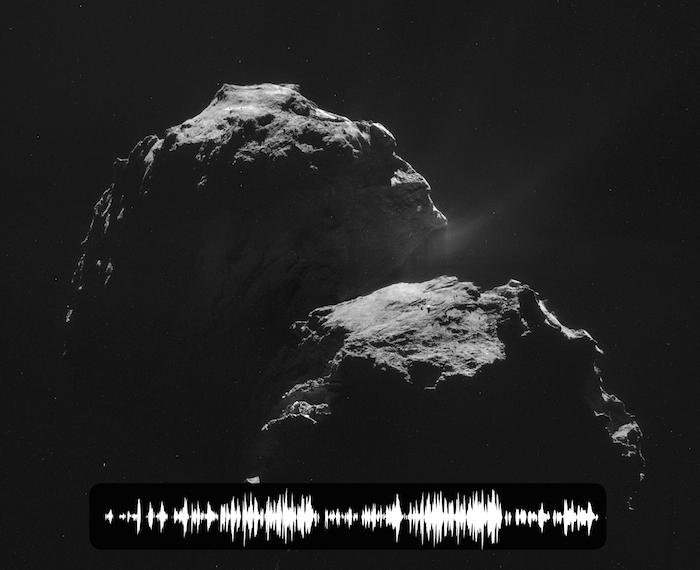
Artist's impression of the 'singing comet' 67P/Churyumov-Gerasimenko. Credit: ESA/Rosetta/NavCam
.
BEHIND THE SCENES OF ‘THE SINGING COMET’
Last month, shortly before Rosetta released Philae to land on Comet 67P/C-G, we posted an article on this blog titled “The singing comet”. It presented an audio track based on data collected with one of the instruments from the Rosetta Plasma Consortium (RPC) on board the orbiter.
Perhaps because it added a new layer to the Rosetta story, by engaging another of our human senses to the immersive experience of “being there” at the comet with the spacecraft, this ‘song’ became a worldwide sensation. By now, it has been listened to more than 5.6 million times on SoundCloud.
But what does this ‘music’ mean, and how is it possible to ‘record’ sounds in space at all? Readers of this blog have asked a number of questions about “The singing comet”, so we’ve written this post to provide some more details about the production of this unusual audio track.
“Clearly, there is no sound as we know it, because acoustic waves need a medium to propagate through, such as an atmosphere, whereas the (almost) empty space around the comet does not allow for that,” explains RPC principal investigator Karl-Heinz Glaßmeier from the Technische Universität Braunschweig, Germany.
“But there is another type of wave that can propagate in the tenuous mixture of charged particles and ions, or plasma, present in the comet’s environment. These magneto-acoustic waves are caused by the interaction of the local plasma around the comet with the magnetic field carried by the solar wind, a stream of electrically charged particles blown by the Sun,” says Karl-Heinz.
While probing the magnetic environment of the comet, the magnetometer on Rosetta (RPC-Mag) detected these waves as very regular oscillations in the local magnetic field. At only a few nanotesla, this field is very weak, roughly a million times less than from a regular fridge magnet, but RPC-Mag is readily able to detect it.
“We cannot see magnetic fields, but we can transform their oscillations and make them audible as if we had magnetic ears.”
The technique used to represent scientific data in an audible form is called ‘sonification’. The first step is to map the data onto frequencies that humans can hear, typically in the range of 20 to 20,000 Hz. The oscillations measured by RPC-Mag exhibit various frequencies in the range between 40 and 50 millihertz, meaning that they change very slowly on timescales of about 20–25 seconds.
“But there was more: since the magnetic field is a vector, it has not one but three components, so it has different oscillations in the three spatial dimensions,” adds Karl-Heinz.
And this is where Manuel Senfft stepped in. A composer and sound designer from Wolfenbüttel, near Braunschweig, Germany, Manuel also enjoys developing software in his spare time, and happily jumped in on this crossover project blending science and music.
“At first, we tried to associate each component of the magnetic field to a different synthesiser and then mix them together, but unfortunately this sound turned out to be quite exhausting to listen to. So we took a different approach, using a ‘stereo spatial positioning’ technique that I developed to make sound ‘evolve’ in a virtual space,” explains Manuel.
.
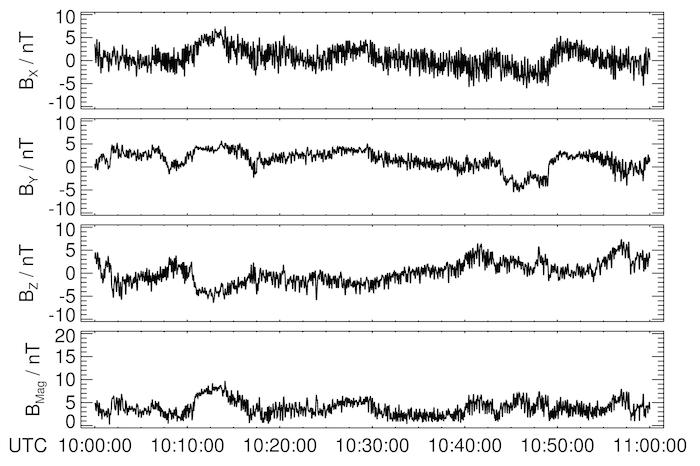
These graphs show an hour of measurements of the magnetic field from the RPC-Mag instrument on Rosetta. The first three graphs show the values of each of the three components of the magnetic field, denoted Bx, By and Bz, respectively; the last graph shows the magnitude of the magnetic field, B_Mag. Image courtesy of Karl-Heinz Glaßmeier, Technische Universität Braunschweig, Germany.
.
With over 85,000 lines of data from only one day of measurements at the comet, Manuel decided to take one of the three components of the magnetic field as the sound itself, with the variations in that component being reflected in the changing pitch. He took samples from the data on a one-minute basis, thus 1440 samples covering the day, and assigned these to MIDI controller values in the audible frequency range. He then mapped these onto a 90 second timeline to create the basic song.
Then he used variations in the other two components of the magnetic field to control the location of the sound in a ‘sound stage’ with respect to the listener, moving it back and forth and left and right.
“This sense of movement conveys the idea that we are moving around the comet, and the RPC team were quite happy about it because, in a way, it’s correct. After all, Rosetta is moving around the comet, even if very slowly,” says Manuel.
Indeed, Rosetta moved just a few kilometres relative to the comet during the day when the data were collected in September 2014.
A final step in Manuel's sonification process was a further compression of the data, squeezing one day’s worth of measurements in the one-and-a-half-minute-long magnetic song of comet 67P/C-G.
“Of course, there is no unique ‘sound’ and this is one of many possible renditions of the magnetic-acoustic oscillations recorded by Rosetta. But in some ways, this is not so different from image processing: if we flew by the comet and looked it through our eyes, we probably wouldn't be able to perceive most of the small intensity variations and shades of grey because the comet is pitch black,” explains Karl-Heinz.
“With our magnetic measurements of the comet’s environment, we chose to combine the data in such a way that makes the most interesting details stand out. Incidentally, we also created a beautiful sound!”
---
MUSIC OF THE IRREGULAR SPHERES
This blog post is contributed by Mark McCaughrean, senior science advisor in the Directorate of Science and Robotic Exploration at ESA.
The rather tortured title of this post is intended as a humorous reference to the decidedly non-spherical shape of Comet 67P/Churyumov-Gerasimenko, the target of our Rosetta mission. It also refers to the philosophical concept of ‘musica universalis’ or ‘music of the spheres’, usually attributed to Pythagoras, Ptolemy, and other ancient philosophers and scientists.
They suggested that the proportions of the distances of the celestial bodies in the Solar System thought to be orbiting the Earth could be assigned tones, much as the pitch of a note coming from a plucked string is related to the length of that string.
This theory was later developed further by Johannes Kepler in his works ‘Mysterium Cosmographicum’ (1596) and ‘Harmonices Mundi’ (1619). In these, Kepler proposed that a series of nested regular polygons provided the basis for the proportions observed in the heavens in a Copernican, Sun-centred Universe, and that the geometrical properties of these polygons could be linked to the ‘music of the spheres’.
Kepler’s work on Tycho Brahe’s astronomical data later led him to his famous laws of planetary motion, which describe the elliptical orbits of objects around the Sun; astronomers would later realise that they even apply to the very elliptical orbits of comets like 67P/C-G. It's interesting to note that one of Kepler’s formative astronomical experiences was seeing the Great Comet of 1577 when he was just six years old. (To read a brief history of comets, please see our earlier blog post "Chasing comets - across history").
In the theory of the ‘music of the spheres’, the sounds are not supposed to be directly audible. That provides a nice link to the now famous “Singing Comet” as presented and described in earlier blog posts, in which magnetic field data from the RPC-Mag instrument on Rosetta was converted into an audible ‘song’ with the collaboration of German composer Manuel Senfft. The song has been played over 5.6 million times online.
.
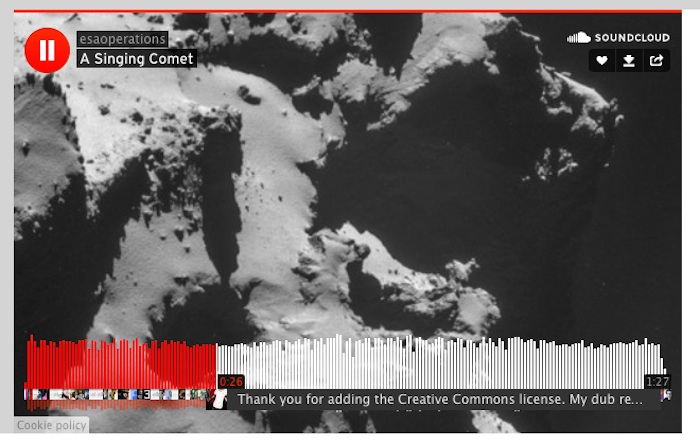
During 2014, Rosetta has also engaged and inspired people to write music spanning a number of genres. We've mentioned some of these in earlier posts, but thought we'd take the opportunity to collect some of those together for your enjoyment and further inspiration as we enter the holiday period over Christmas and New Year.
Earlier in the year, as Rosetta approached 67P/C-G, John Crossley, music producer and programme lead for music production at the University of Derby in the UK, wrote a 45-minute suite simply titled “Rosetta”. Influenced by a wide range of artists from Pink Floyd to Elbow, this suite was performed live on 7 June in full surround sound at the Derby Theatre with his band, Sigma 7, involving students from the university. A documentary, including the full live performance, can be seen on the Syncopate TV YouTube channel, along with stereo and binaural mixes of the seven songs in the suite.Steve Chowne is an engineer who worked in the mid-1990's on the software used by Rosetta during its long hibernation period. Inspired by the successful wake-up from hibernation on 20 January, Steve wrote a 12.5-minute orchestral score covering the mission’s main milestones, which was first performed on 29 November by the Redhill Sinfonia, also in the UK. A recording was made of the concert and will be made available soon, but in the meantime, a synthesised version of the work can be heard on SoundCloud:https://soundcloud.com/steve_chowne
---
COMETWATCH – THE MOVIE
As the incredible year of 2014 draws to a close, we have prepared a small treat for all of the readers of this blog who have followed Rosetta's progress over the months, in particular those who like to download images and play with them.
We started our CometWatch in July, when Rosetta was still a few thousand kilometres away from Comet 67P/Churyumov-Gerasimenko. We saw this curiously-shaped comet grow larger and richer in details as the spacecraft got closer and closer until rendezvous at 100 km on 6 August. The NAVCAM images released over that period provided a good overview of our approach this amazing new world.
In September, as we drew closer to the comet, we had to switch to taking four-image mosaics in order to ensure that we could cover enough of it for navigation purposes. Since then, we have been publishing some of these four-image sets as montages and mosaics, as well as releasing the individual frames so that you could work with them and create your own mosaics. Some have been taken within 8 km of the surface of 67P/C-G, providing amazing views.
But to mark the end of this exciting year, instead of just one new image, montage, or mosaic, the last CometWatch release of the year is ... a movie, featuring no less than 24 montages based on NAVCAM images taken between 19 November and 3 December 2014. A reduced version of the movie can be seen inline here, but the full-sized version is available if you click through.
.
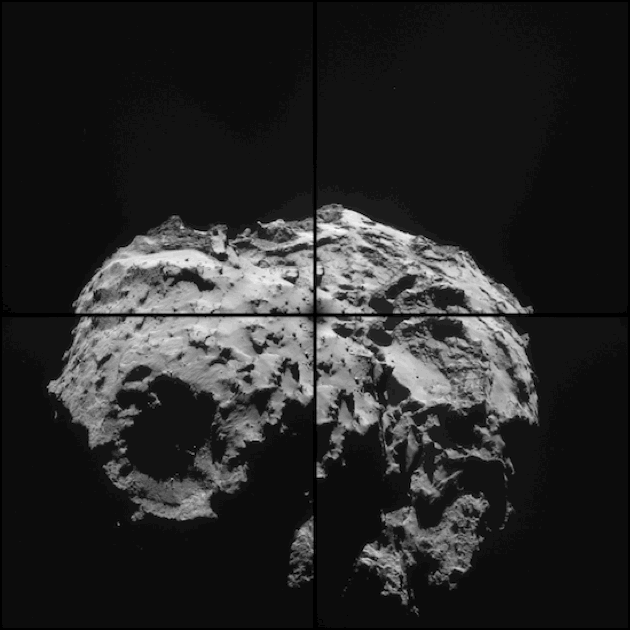
Animation comprising 24 montages based on Rosetta's NAVCAM images acquired between 19 November and 3 December 2014. Credits: ESA/Rosetta/NAVCAM – CC BY-SA IGO 3.0
These images were taken while Rosetta was in a 30-km orbit around the comet (see this video showing the trajectory of the spacecraft after 12 November). As usual, each montage comprises four individual images taken over a 20-minute period, at either around 11:00 UT (12:00 CET) or 23:00 UT (0:00 Next Day CET). At 30 km from the comet's centre, the pixel scale is about 2.56 m/pixel.
.
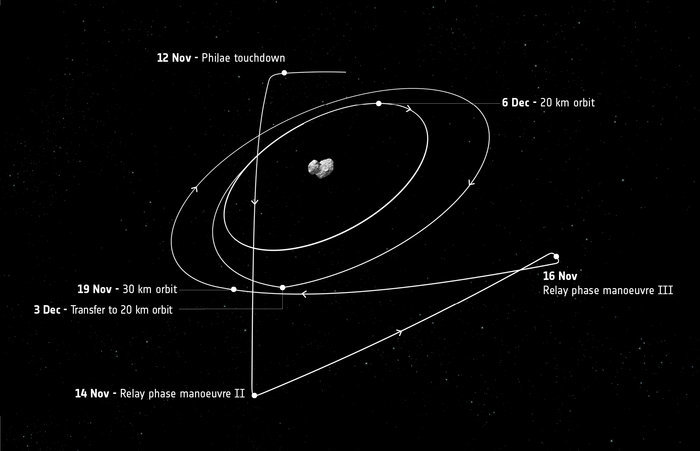
The path of Rosetta after 12 November 2014. Credit: ESA
.
As Comet 67P/C-G rotates with a period of 12.4 hours, images taken at 12-hour intervals result in views that are slightly offset with respect to one another, as the comet will have completed slightly less than a full rotation in that time.
In addition, there is also the orbital motion of Rosetta with respect to the comet: over the two weeks over which the images were taken, Rosetta completed almost one full orbit at 30 km from the comet.
Taking these factors into account, we have ordered the images according to the apparent rotation phase in order to make a movie. In fact, we have sorted the images in an almost reverse chronological sequence, starting with a montage taken on 2 December, then working backwards one day at a time to 19 November. The last montage in the sequence, however, is from 3 December.
Given the limited time available to us in the run up to Christmas, this is all we have been able to do: a phase-ordered sequence of montages made into a movie. There has been no processing of the images apart from the removal of the basic instrumental signature.
But we know that you can do better, and as a thank you to everyone who has produced and shared dozens and dozens of excellent NAVCAM mosaics and images over the past few months, we’ve made the full set of 24 montages and of 96 individual 1024 x 1024 pixel frames available for download.
So, if you have the time over the holiday period, we invite you to create your own mosaics and perhaps even your own movies, and to share them on your social networks under the terms of the Creative Commons licence that applies to NAVCAM images (CC BY-SA IGO 3.0). Let us know about them in the New Year.
For those who want to know exactly where the spacecraft was at the moment when each image was taken and perhaps factor that into their movie-making, the so-called 'SPICE' files for Rosetta are available here, and the tools to read and process those files can be found here. Few parameters are already included in the filenames of the provided images, such as rotation phase, date and time (rot.phase_ESA_ROSETTA_NAVCAM_yymmddThh).
We hope you have enjoyed following our CometWatch in 2014 and we are looking forward to another exciting year as 67P/C-G gets closer and closer to the Sun. Rosetta will be there to monitor its changes and discover what it really means “to live with a comet”.
---
YEAR-END BREAK
ESA_Rosetta_Seasons GreetingsA short note from the blog team here at ESA: after an amazing but exhausting year, we're going to take a year-end break between Monday, 22 December 2014 and Monday, 5 January 2015. Over this fortnight, we do not expect to receive any new information from the Rosetta scientists or mission teams, and so do not foresee any new routine posts, including NAVCAM images.
The only exception might be if Philae is located in images taken by Rosetta in recent days and, in that case, we'd aim to bring you the news as soon as possible.
In addition, due to the time required to review and moderate comments, we're going to disable the commenting function on all posts/pages over this period; existing comments will remain, but no new comments can be submitted and added during the break. This will be re-enabled on 5 January.
It has been a huge pleasure running this blog in 2014! From the anticipation of the 20 January wake-up to the 6 August rendezvous and then the 12 November landing, it has been a real roller-coaster ride for everyone involved here at ESA and in all the Rosetta teams.
And we've had a fantastic experience watching this passionate outside community grow and we would like to pass on our thanks to the hundreds (or has it been thousands?) of people from all around the world who have taken time to follow along, to contribute, and to share their enthusiasm for the Rosetta mission.
We have appreciated all the queries, comments, replies, opinions, counter-opinions and, indeed, multiple arguments that have been posted. We hope that we've done an acceptable job of allowing the myriad of valid opinions and heartfelt viewpoints - even the ones we (or others) disagreed with - while wielding a deft touch in disallowing the comments and posts that were beyond the pale.
Thank you for your support, passion and genuine enthusiasm for the Rosetta mission in 2014. You have all helped make the mission a worldwide phenomenon.
We look forward to having you back 'on the blog' in the New Year. After all, as Comet 67P/C-G moves in towards its closest point to the Sun in August, we're promised a grandstand view of the fireworks from Rosetta, and there should be plenty to share and discuss. In many ways, the mission has just begun!
Best wishes for a joyful year-end holiday and a happy and healthy 2015.
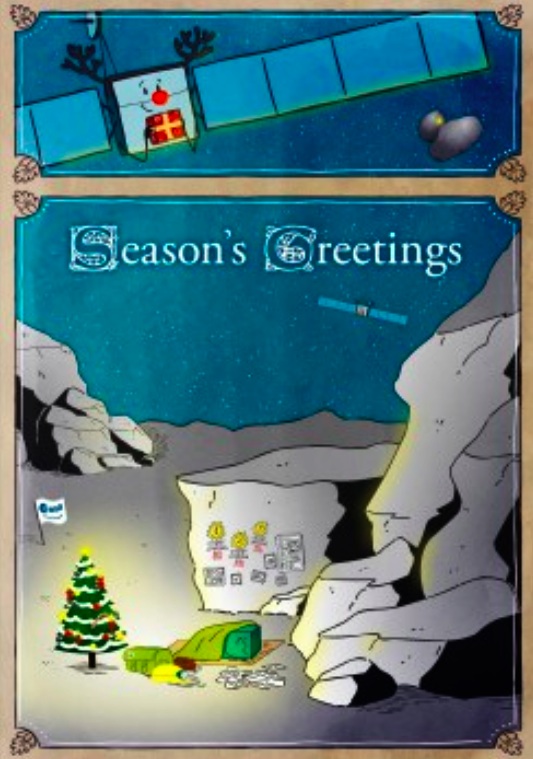
– Rosetta blog team
Quelle: ESA
---
Update: 7.01.2015
.
ROSETTA IN 2015
Before the Christmas break we left you with a bounty of comet images to create a movie – if you took on the challenge, do post links to your videos on the relevant post: CometWatch – the movie. We are looking forward to seeing your mosaics and movies!
We were also keeping our ear to the ground for an update on the whereabouts of Philae, but attempts to identify the lander in high-resolution OSIRIS images acquired from a distance of 20 km have reportedly not yet been successful. (Note, the link is to a German news story in which OSIRIS PI Holger Sierks told the Göttinger Tageblatt “We have still not discovered the lander.”) The scientists continue to scour the images for confirmation of the landing site.
.
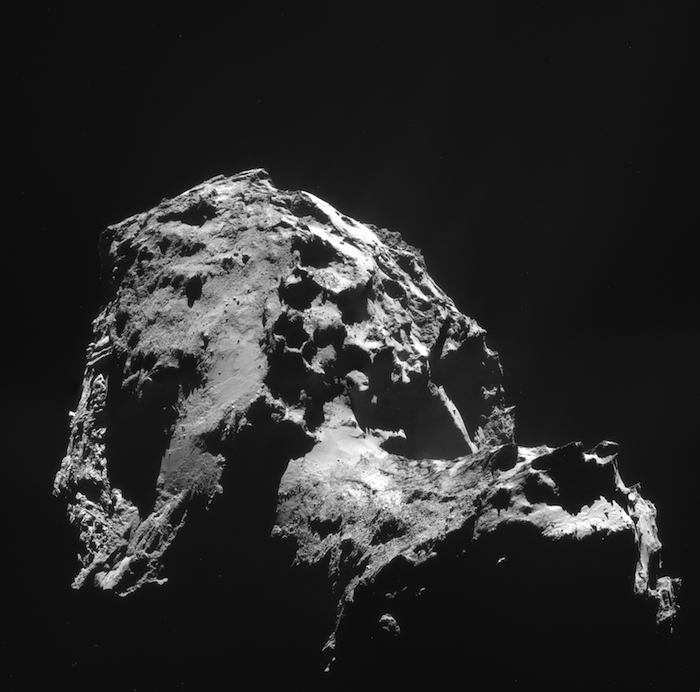
Four-image mosaic of Comet 67P/C-G comprising images taken on 1 January 2015. Credits: ESA/Rosetta/NAVCAM – CC BY-SA IGO 3.0
.
Rosetta is now orbiting comet 67P/C-G at a distance of about 30 km. The images included in today’s post were the first to be taken in 2015, acquired shortly after midnight UTC spacecraft time on 1 January from a distance of 28.4 km from the comet centre. The mosaic, oriented with the smaller lobe on the right and the larger lobe on the left, has a resolution of 2.4 metres/pixel and measures 4.1 x 4.0 km. The four individual 1024 x 1024 NAVCAM frames making up the mosaic, which each measure about 2.5 km across, are provided at the end of this post. Because rotation and translation of the comet during the imaging sequence make it difficult to create an accurate mosaic, always refer to the individual images before drawing conclusions about any strange structures or low intensity extended emission. For example, there are artefacts in this mosaic on the far left and towards the centre of the image, respectively.
.
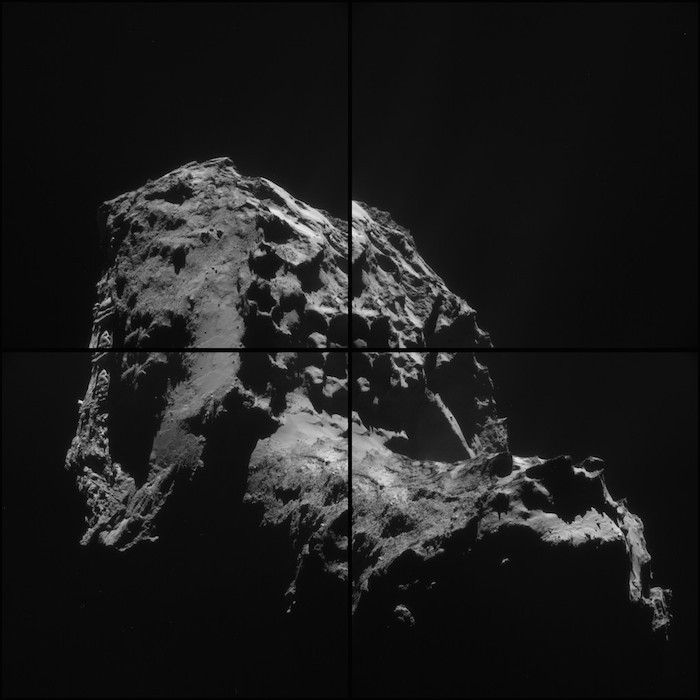
Montage of the 1 January 2015 images. Credits: ESA/Rosetta/NAVCAM – CC BY-SA IGO 3.0
.
Rosetta will continue in its 30 km orbit until 3 February, before building up to its closest flyby yet. On 4 February, Rosetta will start to move some 140 km from the comet, before swooping down to just 6 km from the surface on 14 February.
This close flyby will allow instruments to take images and spectra of the surface with unprecedented resolution and to directly sample the very inner cometary coma in order to learn more about how the comet’s characteristic coma and tail are created.
After this exciting event, Rosetta will continue making a series of flybys of the comet, the exact distance determined by the activity of the comet at any given time. The activity is expected to increase over the coming months as the comet moves ever closer to perihelion on 13 August. That is, the closest distance to the Sun along its orbit, which for 67P/C-G is 186 million kilometres, roughly between the orbits of Earth and Mars. Rosetta will be watching as the activity increases and then subsides again, and how the comet’s surface features change and evolve during this period.
Scientists also hope that the increasing solar energy in the coming months will be enough to revive the lander Philae from its hibernation.
In between these mission milestones there will be regular releases of science papers and data (dates of data releases TBC). Presentations of the latest analyses will also be made at science conferences over the course of the year, including EGU (April), EPSC (September) and AGU (December). We’ll continue to report on the key science results here on the blog and/or via the main ESA web portal.
We’ll also be continuing with our regular CometWatch releases via the blog.
The individual 1024 x 1024 pixel NAVCAM image frames for today’s CometWatch entry are provided below. As ever, we encourage you to create mosaics and share them on your social media channels with the credit line: ESA/Rosetta/NAVCAM – CC BY-SA IGO 3.0.
.
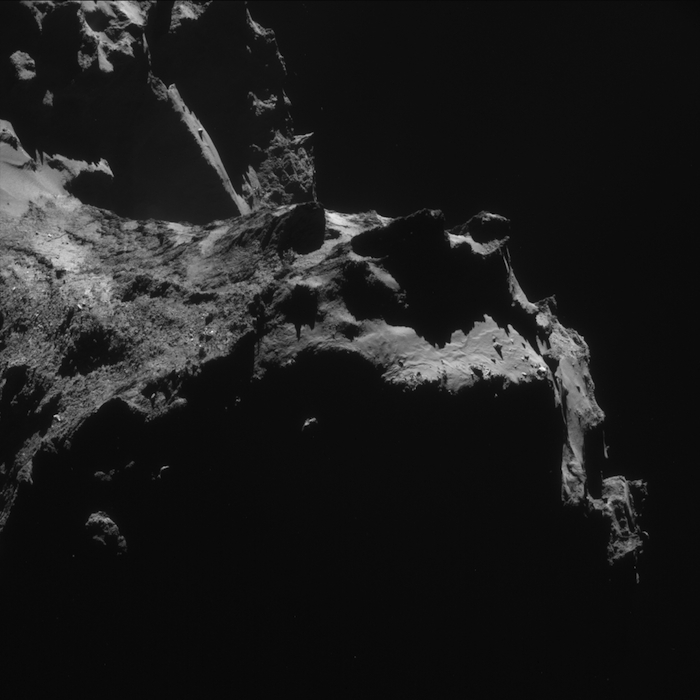
Quelle: ESA
.
Update: 8.01.2015
-
COMETWATCH – 3 JANUARY
This four-image mosaic comprises images taken from a distance of 28.4 km from the centre of Comet 67P/Churyumov-Gerasimenko on 3 January. The image resolution at this distance is 2.4 m/pixel and the individual 1024 x 1024 frames measure 2.5 km across. The mosaic is slightly cropped and rotated and measures about 4.4 x 4.2 km.
Because rotation and translation of the comet during the imaging sequence make it difficult to create an accurate mosaic, always refer to the individual images before drawing conclusions about any strange structures or low intensity extended emission.
.
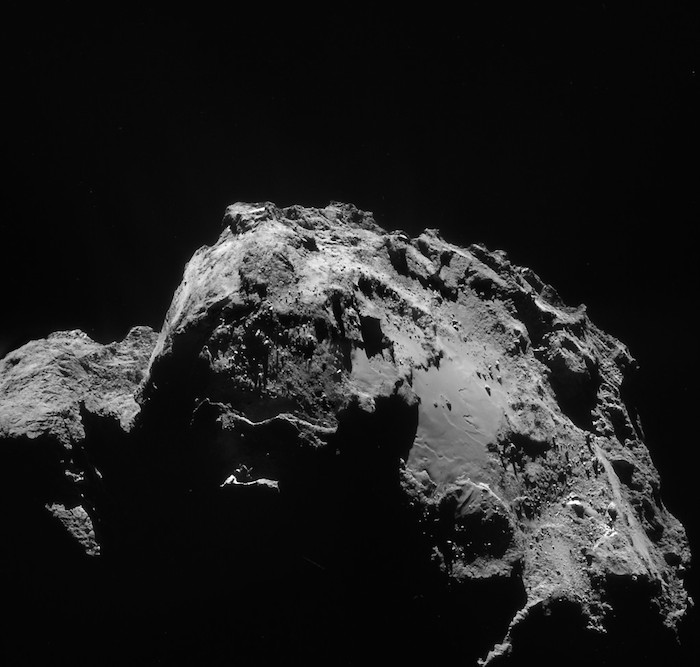
Four-image mosaic of Comet 67P/C-G comprising images taken on 3 January 2015. Credits: ESA/Rosetta/NAVCAM – CC BY-SA IGO 3.0
.
The mosaic shows a great view across the Imhotep region, which includes the Cheops boulder on the larger of the two comet lobes. The name of this region was revealed during the AGU conference in December (see the 17 Dec post). The smaller of the comet’s lobes is situated to the far left of the mosaic.
The illumination conditions contribute to the interesting view of the features standing out against the shadowed foreground, close to the centre.
Some of the streaks and specks seen around the nucleus will likely be dust grains ejected from the comet, captured in the 4.3 second exposure time.
A montage and the four individual 1024 x 1024 frames are provided below:
.
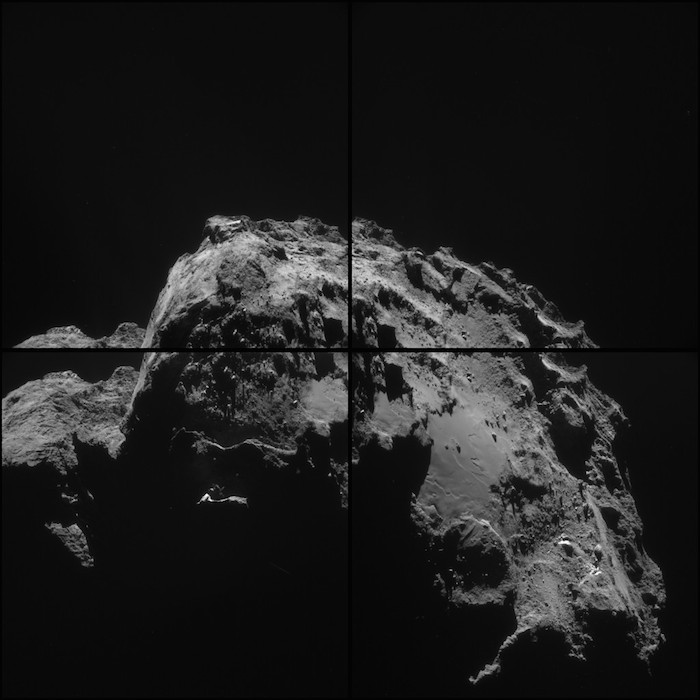
--
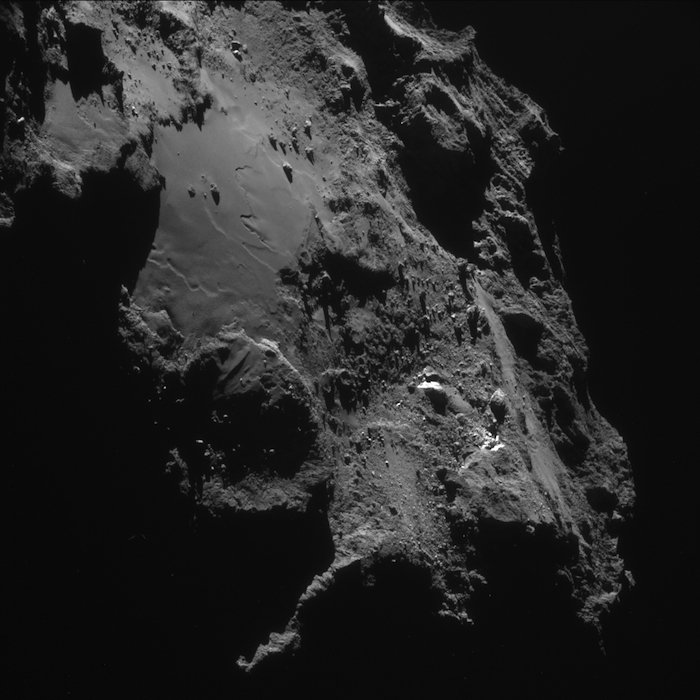
Quelle: ESA
.
Update: 12.01.2015
-
COMETWATCH – 6 JANUARY
This four-image montage comprises images taken from a distance of 27.9 km from the centre of Comet 67P/Churyumov-Gerasimenko on 6 January. The image resolution at this distance is 2.3 m/pixel and the individual 1024 x 1024 frames measure about 2.4 km across.
.
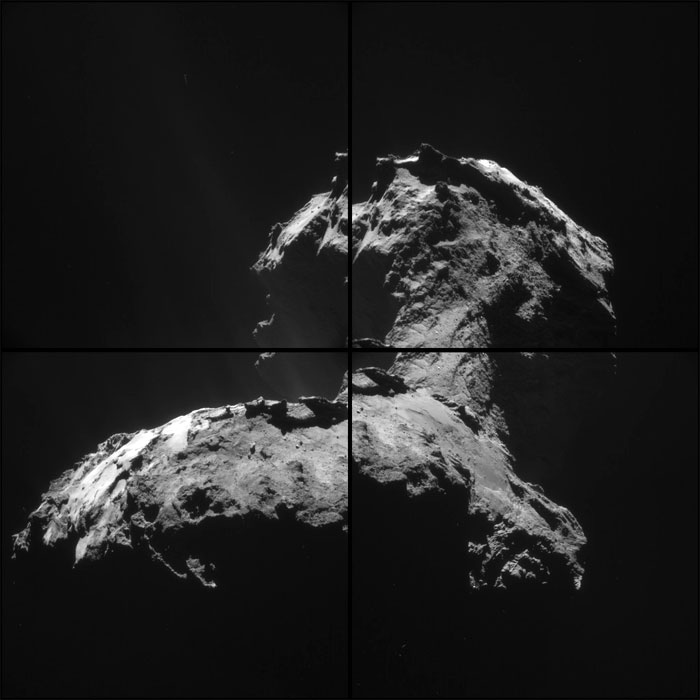
Montage of four NAVCAM images taken of Comet 67P/Churyumov-Gerasimenko on 6 January 2015. Credits: ESA/Rosetta/NAVCAM – CC BY-SA IGO 3.0
Rotation and translation of the comet during the imaging sequence make it difficult to create an accurate mosaic, so if you attempt a mosaic always refer to the individual images before drawing conclusions about any strange structures or low intensity extended emission.
The scene provides a nice view across the larger lobe (foreground) and up onto the smaller comet lobe (upper frames), taking in a wide range of surface textures from smooth regions with scattered boulders to rougher and more complex terrains.
Ramp up the exposure to bring out more details of the cliffs leading up to the smaller lobe, and to capture some of the comet's activity.
The four individual frames are provided below:
.
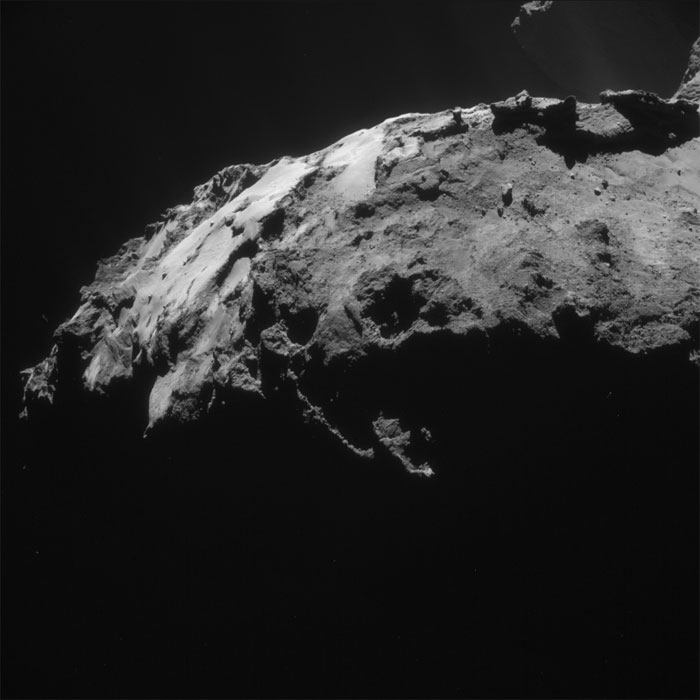
.
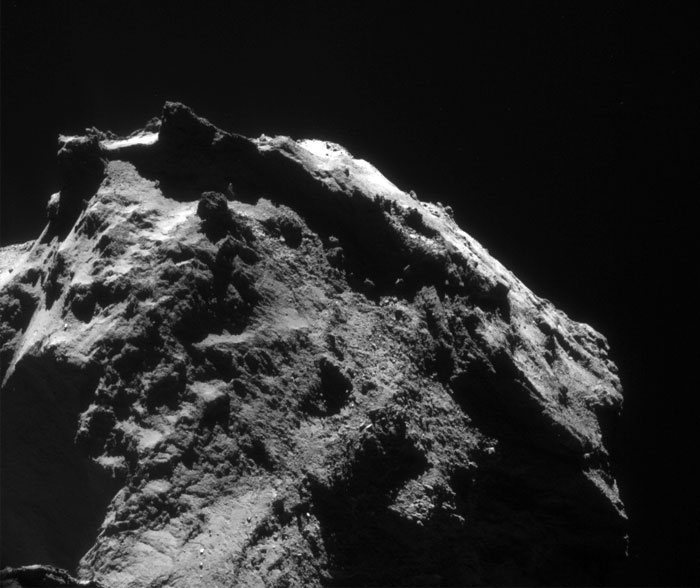
Quelle: ESA
.
Update: 15.01.2015
.
COMETWATCH – 8 JANUARY
This four-image mosaic comprises images taken from a distance of 27.5 km from the centre of Comet 67P/Churyumov-Gerasimenko on 8 January. The image resolution at this distance is about 2.3 m/pixel and the individual 1024 x 1024 frames measure about 2.4 km across. The mosaic measures 4.3 x 3.9 km.
.
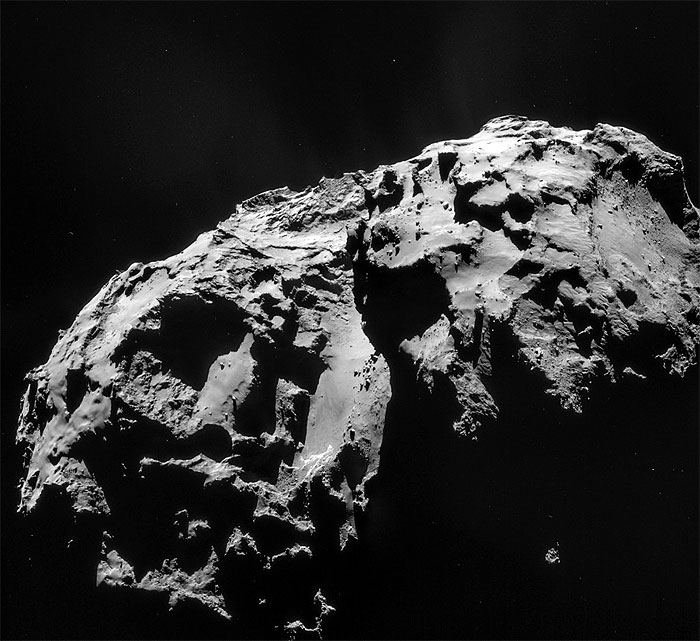
Four image mosaic comprising images taken on 8 January 2015. Rotation and translation of the comet during the imaging sequence make it difficult to create an accurate mosaic, so always refer to the individual images before drawing conclusions about any strange structures or low intensity extended emission. Credits: ESA/Rosetta/NAVCAM – CC BY-SA IGO 3.0
.
In this view the smaller of the comet’s two lobes is to the right, presenting a side-on look into the large, roughly 1 km-wide depression towards the edge of the mosaic. The rugged outline of the smaller lobe can be traced into the shadows, creating a nice contrast against the smooth neck region in the centre of the image. As noted in the 9 December CometWatch this portion of the neck has some particularly interesting features, such as the bright, exposed cliffs, the curved trough-like features and dark markings in the dusty layer.
To the left, the image offers a striking view of the large comet lobe, in particular the steep, layered cliff face that towers above a smoother, dust-covered ledge. At its edge, it appears as though some of the dust may have slipped away. Towards the background, ridges seem to cut through the terrain, while several flat-topped plateaus are set along the horizon.
The four individual 1024 x 1024 frames, along with a montage of the four frames, are provided below:
.
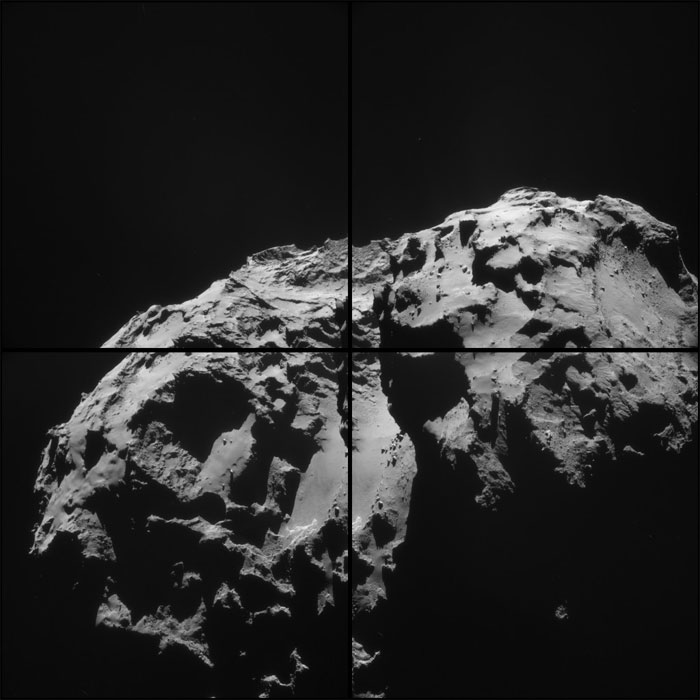
-
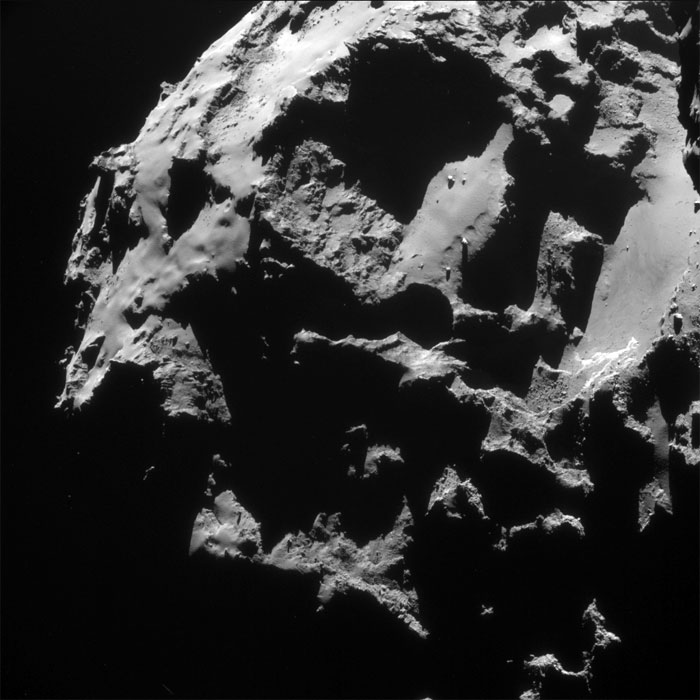
Quelle: ESA
.
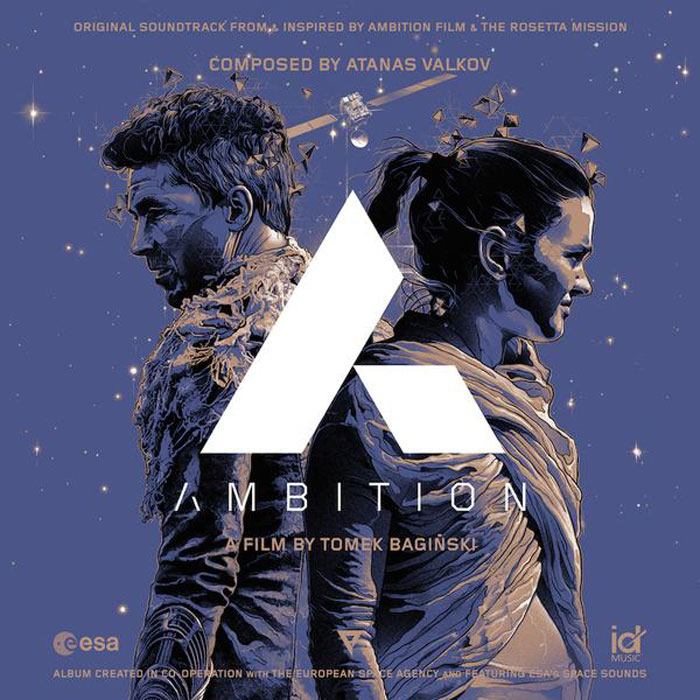
“AMBITION”
ORIGINAL SOUNDTRACK FROM & INSPIRED BY AMBITION & THE ROSETTA MISSION
OUT NOW
Warsaw, Poland (15.01.2015) - Composed and produced by Atanas Valkov, the “Ambition” album has just premiered in online music stores and on streaming platforms, including iTunes, Google Play, Spotify, and many others. The album features 15 originaltracks of electronic, cinematic, and world music.
The album is inspired by the European Space Agency’s historic Rosettamission and the film “Ambition” (directed by Tomek Bagiński, starring Aidan Gillen and Aisling Franciosi), whose soundtrack was composed and produced by Atanas.
The “Ambition” album features sounds recorded by the European Space Agency (ESA) during some of humanity’s most daring space voyages. Disguised as part of the music and sound effectsthrough sound design technologies, these samples blended in with the music to help shapethe composer’s “love project”.
“It’s a one-of-a-kind sonic voyage into outer space, combining the realms of music, film, and science. What drives human beings to achieve great things is ambition. I felt that I really wanted to pay tribute to the incredible achievement that was the success of the Rosetta mission, so I used the film score, ESA’s sound vault, and my music to produce this feature album”, Atanas said.
The album also features the voices of special guests from the European Space Agency, including astronaut Alexander Gerst, Prof MarkMcCaughrean, and Prof David Southwood. The track called “Stubborn” features Mavin, a Berlin-based singer and songwriter, who provided unique flavour as he sang about conflicts between emotion and experience, and bitter lessons learned.
“Ambition” is Atanas’ second feature album.
The album trailer has been published online and can be viewed here. A free promo of the album is available for streaming on Atanas’ soundcloud.
STORE LINKS :
Spotify http://sptfy.com/ambition
Google Play http://goo.gl/BqKONH
iTunes http://bitly.com/1IMD8HG
Deezer http://www.deezer.com/album/9489722
Quelle: ESA
.
Update: 17.01.2015
.
FINE STRUCTURE IN THE COMET’S JETS
In the first OSIRIS image release of 2015, the team provides an unprecedented look at the finer details of 67P/C-G’s dust jets.
Comet 67P/Churyumov-Gerasimenko has shown activity in the form of jets for many months now, but the latest image reveals that the large-scale jets seen in previous images can now be resolved into many smaller jets emerging from the surface, which seem to merge together further away from the comet nucleus. Although much activity still emanates from the ‘neck’ region, jets are also appearing from both of the comet’s two lobes.
.
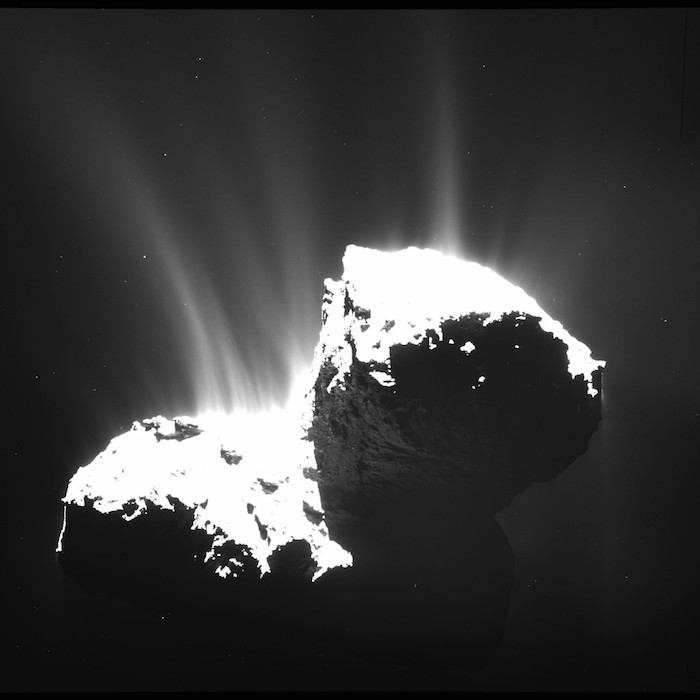
OSIRIS wide-angle camera image acquired on 22 November 2014 from a distance of 30 km from Comet 67P/C-G. The image resolution is 2.8 m/pixel. The vertical line in the bottom right of the image, which seems to separate two regions of the coma with slightly different brightness, is the shadow of the nucleus cast onto the coma.
Credits: ESA/Rosetta/MPS for OSIRIS Team MPS/UPD/LAM/IAA/SSO/INTA/UPM/DASP/IDA
The image presented here was taken on 22 November 2014 by the OSIRIS wide-angle camera, from a distance of 30 km. It is part of a set of observations dedicated to the investigation of the comet’s general activity. As such, the nucleus is deliberately overexposed in order to reveal faint jets and the collimated nature of the streams of gas and dust rising from the surface.
“This is still the beginning of the activity compared to what we expect to see in summer this year,” says OSIRIS principal investigator Holger Sierks from the Max Planck Institute for Solar System Research (MPS) in Germany. “From the last perihelion passage we know that the comet will evolve by a factor of 100 in activity at that time compared to now.”
But the jets are already strong enough now to show distinct features, from which the OSIRIS scientists aim to understand the physical processes that are creating and shaping them.
In this particular study, the jets were observed over one full comet rotation. “By tracking them from image to image, we reconstruct their three-dimensional structures and link them to specific areas on the nucleus, of which the morphology and composition is now being investigated,” explains OSIRIS scientist Jean-Baptiste Vincent from MPS.
By understanding where exactly the jets are emerging, e.g., from the cliffs or plains, the scientists will learn exactly how the activity is generated. The scientists will also learn how the jets interact with the dust particles and gas coma that is surrounding the nucleus, but which is only clearly visible at much greater distances from the comet (for example, take a look at the coma as seen through the ground-based VLT).
In addition to the jets, the new image also reveals surface features from the “dark-side” of the comet. Although this region is not yet illuminated directly – this will happen as the comet moves ever closer to perihelion in August this year – the diffuse light reflected from other areas allows a glimpse of what is to come.
---
COMETWATCH 10 JANUARY
This four-image mosaic comprises images taken from a distance of 27.5 km from the centre of Comet 67P/Churyumov-Gerasimenko on 10 January. The image resolution is 2.3 m/pixel and the individual 1024 x 1024 frames measure 2.4 km across. The mosaic is slightly cropped and measures 4.2 x 3.8 km.
.
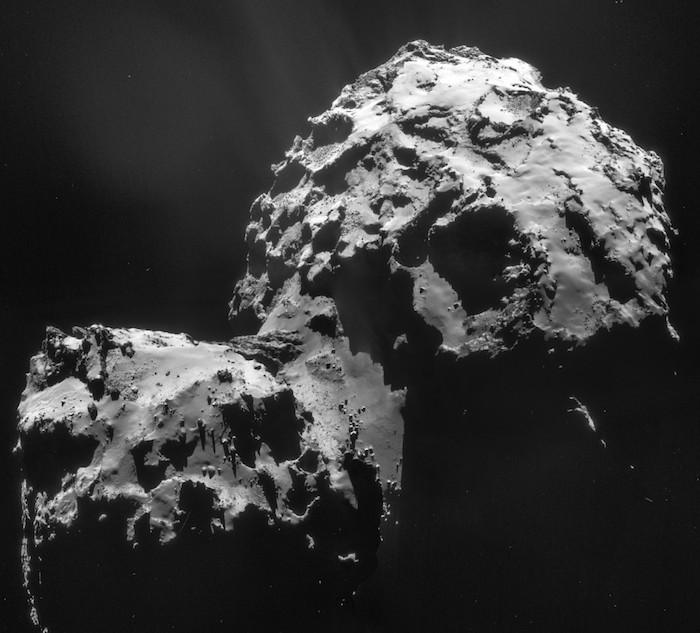
Four image mosaic comprising images taken on 10 January 2015. Rotation and translation of the comet during the imaging sequence make it difficult to create an accurate mosaic, so always refer to the individual images before drawing conclusions about any strange structures or low intensity extended emission. Credits: ESA/Rosetta/NAVCAM – CC BY-SA IGO 3.0
The image shows the smaller lobe of the comet in the lower left corner, and the larger lobe to the upper right. The smaller lobe is actually in the foreground, and its rotation over the time elapsed between the first and the fourth frame is significant, making the mosaic particularly tricky.
The intricate patterns of pits and other roundish, hollow features on the larger of the comet's lobes stand out beautifully in this view, along with a number of boulders, particularly on the smaller lobe and across the neck.
The four individual 1024 x 1024 frames, along with a montage of the frames, are provided below:
.
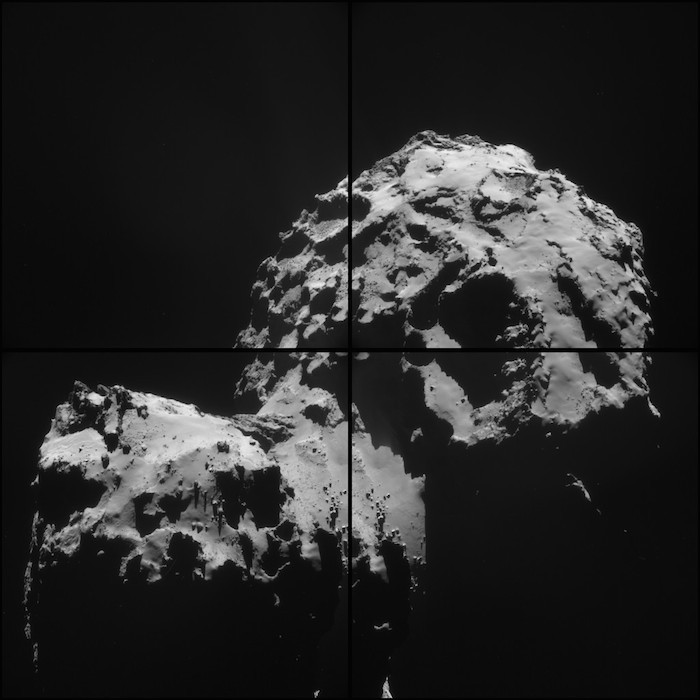
Quelle: ESA
.
Update: 19.01.2015
.
COMETWATCH 12 JANUARY
This four-image mosaic comprises images taken from a distance of 27.9 km from the centre of Comet 67P/Churyumov-Gerasimenko on 12 January. The image resolution is 2.4 m/pixel and the individual 1024 x 1024 frames measure 2.4 km across. The mosaic is slightly cropped and measures 4.4 x 3.9 km.
.
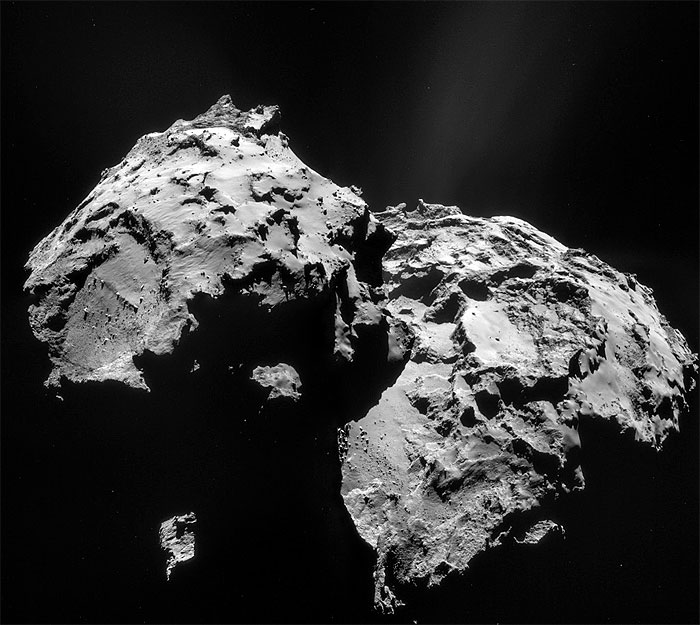
Four image mosaic comprising images taken on 12 January 2015 by Rosetta's Navigation Camera (NAVCAM). Rotation and translation of the comet during the imaging sequence make it difficult to create an accurate mosaic, and there may be some spurious spatial and intensity features as a result of the mosaic-making sequence, so always refer to the individual frames before performing any detailed comparison or drawing conclusions about any strange structures or low intensity extended emission. Credits: ESA/Rosetta/NAVCAM – CC BY-SA IGO 3.0
This view is complementary to the 8 January CometWatch, with the comet's smaller lobe in the foreground, but this time on the left. The new view provides a side-on look onto the large and roughly circular depression close to the Agilkia site, but this time from the opposite side, revealing parts of the cavity that were hidden from sight in the 8 January image.
The larger of the two comet's lobe fills the right half of the image. While the light effect is less dramatic than in the 8 January image due to a different orientation of the shadows, the new view perhaps allows a better comparison between different surface features. Indeed, the view incorporates the smooth surface along the comet's neck, itself covered in dust and boulders, to pitted terrains interspersed with smoother patches, boulders and cliffs.
The four individual 1024 x 1024 frames, along with a montage of the frames, are provided below:
-
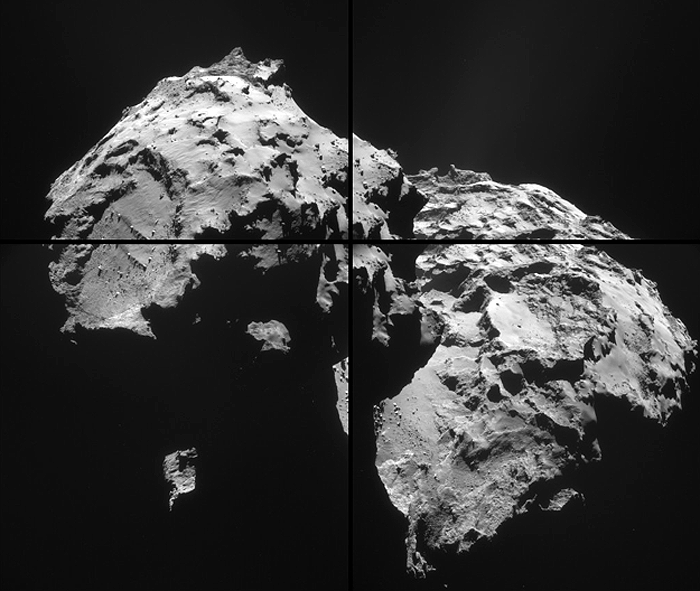
-
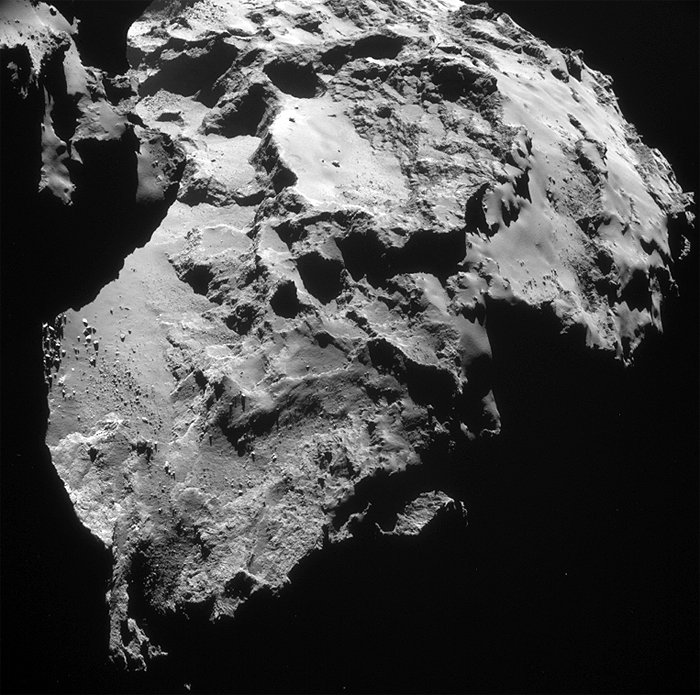
Quelle: ESA
.
Update: 21.01.2015
.
COMETWATCH 16 JANUARY
This four-image mosaic comprises images taken from a distance of 28.4 km from the centre of Comet 67P/Churyumov-Gerasimenko on 16 January. The image resolution is 2.4 m/pixel and the individual 1024 x 1024 frames measure 2.5 km across. The mosaic is slightly cropped and rotated, and measures 4.5 x 4.2 km.
-
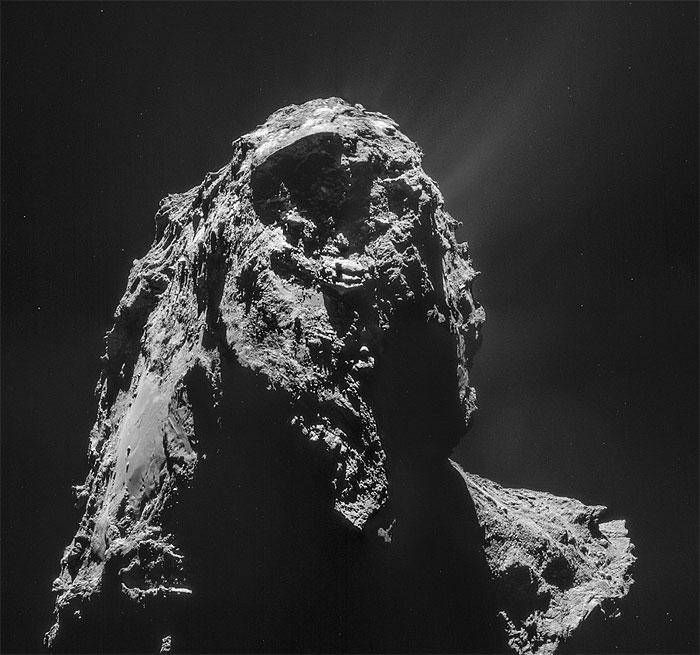
Four image mosaic comprising images taken on 16 January 2015 by Rosetta's Navigation Camera (NAVCAM). Rotation and translation of the comet during the imaging sequence make it difficult to create an accurate mosaic, and there may be some spurious spatial and intensity features as a result of the mosaic-making sequence, so always refer to the individual frames before performing any detailed comparison or drawing conclusions about any strange structures or low intensity extended emission. Credits: ESA/Rosetta/NAVCAM – CC BY-SA IGO 3.0
-
The image portrays 67P/C-G from an unusual angle, providing a side view onto the Imhotep region, home to Cheops and its neighbouring boulders on the underside of the comet's larger lobe (left hand side of the image). At the same time, the rough terrains and cliffs on the transition region between the comet's neck and its smaller lobe can also be seen, steeply declining towards the well-defined edge in the lower right corner of the image.
While the curious orientation of the comet in this image is similar to that of the 2 November CometWatch, a slightly different illumination reveals a wealth of surface details on one of the sides of the larger lobe (in the foreground in this image) that were previously hidden.
Among the interesting features that now stand out are what appears to be a series of almost parallel structures visible just above the image centre and, below them, a secluded pocket of smooth terrain punctuated with a few boulders. Also in contrast to the 2 November view, we can now see the crisp outline of the comet's larger lobe and signs of cometary activity towards the top left of the image.
The four individual 1024 x 1024 frames, along with a montage of the frames, are provided below:
.
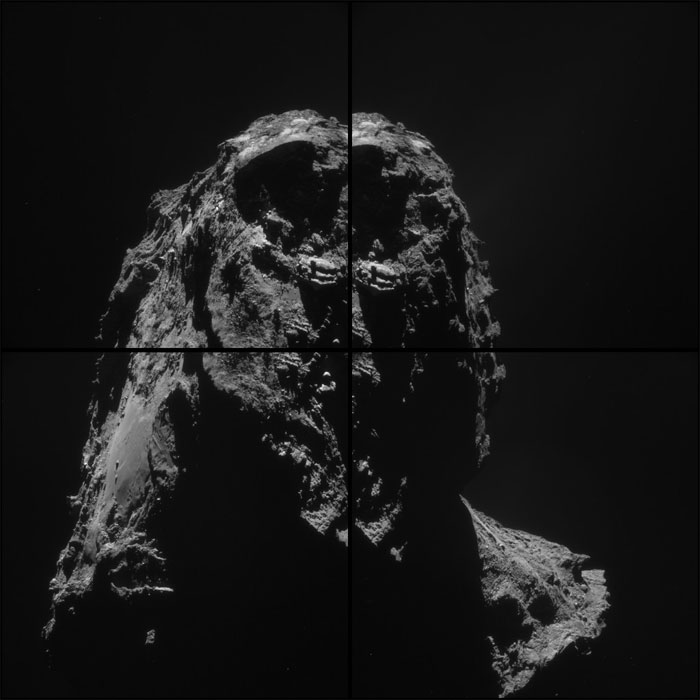
-
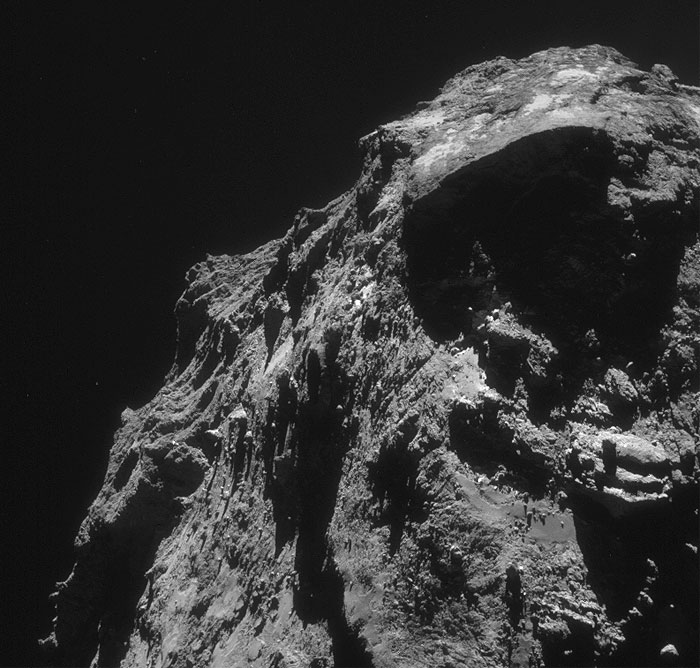
-
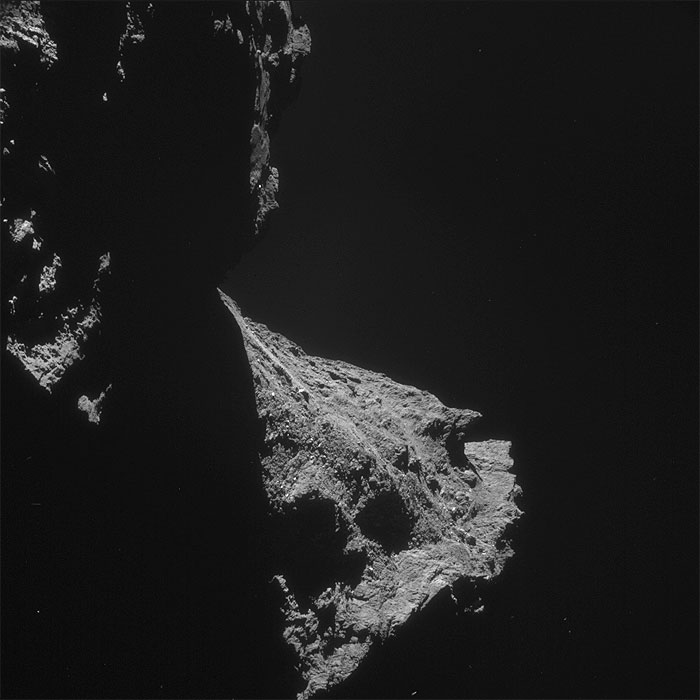
Quelle: ESA
4782 Views
